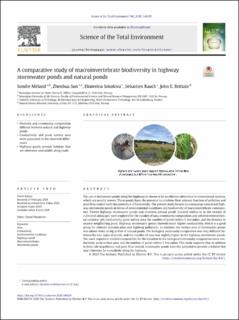A comparative study of macroinvertebrate biodiversity in highway stormwater ponds and natural ponds
Peer reviewed, Journal article
Published version
Permanent lenke
https://hdl.handle.net/11250/2671710Utgivelsesdato
2020Metadata
Vis full innførselSamlinger
Sammendrag
The use of stormwater ponds along the highways is shown to be an effective alternative to conventional systems, which are usually sewers. These ponds have the potential to combine their primary function of pollution and peak flow control with the promotion of biodiversity. The present study focuses on comparing natural and highway stormwater ponds in terms of environmental conditions and biodiversity of macroinvertebrate communities. Twelve highway stormwater ponds and nineteen natural ponds (located within or in the vicinity of cultivated landscape) were explored for the number of taxa, community composition, and selected environmental variables: pH, conductivity, pond surface area, the number of ponds within 1 km radius, and the distance to nearest neighboring pond. Highway stormwater ponds showed much higher conductivity, which is a good proxy for chloride concentration and highway pollutants. In addition, the surface area of stormwater ponds was almost twice as big as that of natural ponds. The biological community composition was very different between the two types of ponds, and the number of taxa was slightly higher in the highway stormwater ponds. The most important variables responsible for the variation in the biological community composition were conductivity, pond surface area, and the number of ponds within 1 km radius. This study supports that, in addition to their role in pollution and peak flow control, stormwater ponds have the potential to provide a habitat that may otherwise be unavailable along the highway.
